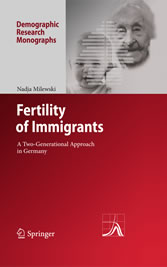Search and Find
Service
Foreword
6
Acknowledgments
10
Contents
11
List of Figures
14
List of Tables
15
Chapter 1 Introduction
18
1.1 Germany’s Immigration History After 1945
19
1.1.1 Expellees (Vertriebene) and In-Migrating Ethnic Germans (Aussiedler)
20
1.1.2 “Guest Workers” (Gastarbeiter) in West Germany
22
1.1.3 Foreign Workers (Vertragsarbeiter) in the Former GDR
25
1.1.4 Refugees and Asylum Seekers
26
1.1.5 Summary: Immigrants and Their Descendants in Germany
27
1.2 Introduction to Fertility of Immigrants in Germany
29
1.3 Research Questions and Structure of the Study
32
Chapter 2 Theory and Empirical Findings in Previous Investigations
35
2.1 Migration and Fertility
35
2.1.1 Disruption
37
2.1.2 Interrelation of Events
38
2.1.3 Adaptation
39
2.1.4 Socialization
43
2.1.5 Selection and Characteristics
44
2.1.6 Legitimacy
48
2.1.7 Minority Groups
48
2.1.8 Socio-Demographic Characteristics and Economic Arguments
49
2.1.9 Independence-Effect: Sub-Culture and Minority Status
50
2.1.10 Synthesis: Theories
54
2.2 Family-Formation Context in the Countries of Origin
56
2.2.1 Italy and Spain
57
2.2.2 Turkey
59
2.2.3 Former Yugoslavia
62
2.2.4 Greece
63
2.2.5 Intermediate Conclusion
64
2.3 Socio-Demographic Characteristics of “Guest Workers” and Their Descendants in Germany
65
2.3.1 Legal Status
65
2.3.2 Education
67
2.3.3 Occupation
68
2.3.4 Religious Affiliation
71
2.3.5 Social Interaction and Marriage Behavior
72
2.4 Research Summary: Fertility of “Guest Workers” in Germany
74
2.4.1 Period, Age, and Time Effects
74
2.4.2 Individual Factors Influencing Fertility
77
2.4.3 Contextual and Cultural Factors
79
2.4.4 Reflections in the Light of Theory
81
2.5 Research Approach and Working Hypotheses
85
2.5.1 The Life-Course Approach
85
2.5.2 Hypotheses, Part 1 – Entry into Motherhood
88
2.5.3 Hypotheses, Part II – Transitions to a Second and a Third Child
91
Chapter 3 Empirical Analysis
94
3.1 Data, Method, and Explanatory Variables
94
3.1.1 Data
94
3.1.2 Method
97
3.1.3 Explanatory Variables
98
3.2 Introductory Description of the Sample
107
3.2.1 Marriage
107
3.2.2 Completed Family Size
111
3.3 Results: Transition to a First Child
112
3.3.1 Kaplan–Meier Survival Estimates
113
3.3.2 Immigrant Generation and Baseline Intensity (Age of the Woman)
117
3.3.3 Stay Duration of First-Generation Immigrants
118
3.3.4 Marriage Duration
119
3.3.5 Women’s Characteristics
121
3.3.6 Partner’s Characteristics
123
3.3.7 Immigration Background
123
3.3.8 Further Covariates
126
3.3.9 Intermediate Conclusion
127
3.4 Results: Transition to a Second Child
128
3.4.1 Kaplan–Meier Survival Estimates
128
3.4.2 Immigrant Generation and Baseline Intensity (Age of the First Child)
130
3.4.3 Stay Duration of First-Generation Immigrants
132
3.4.4 Women’s Characteristics
133
3.4.5 Partner’s Characteristics
135
3.4.6 Immigration Background
135
3.4.7 Further Covariates
137
3.4.8 Intermediate Conclusion
137
3.5 Results: Transition to a Third Child
138
3.5.1 Kaplan–Meier Survival Estimates
138
3.5.2 Immigrant Generation and Baseline Intensity (Age of the Second Child)
140
3.5.3 Stay Duration of First-Generation Immigrants
142
3.5.4 Women’s Characteristics
143
3.5.5 Partner’s Educational Attainment
144
3.5.6 Immigration Background
144
3.5.7 Further Covariates
146
3.5.8 Intermediate Conclusion
146
Chapter 4 Discussion
147
4.1 Conclusions for Hypotheses
147
4.1.1 Disruption
147
4.1.2 Interrelation of Events
148
4.1.3 Adaptation
150
4.1.4 Selection and Characteristics
152
4.1.5 Socialization
153
4.2 Reflections and Perspectives
155
4.2.1 Disruption and Union Dissolution
155
4.2.2 Adaptation and Selection of First-Generation Immigrants
156
4.2.3 Second-Generation Immigrants
157
4.2.4 Family Patterns
157
Chapter 5 Summary
159
Appendix
163
First-Child Analysis
163
Second-Child Analysis
168
Third-Child Analysis
172
References
175
All prices incl. VAT













